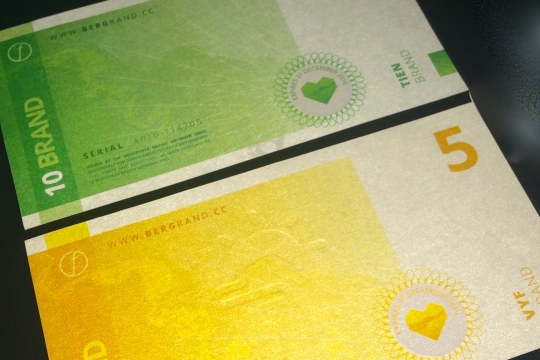A tattoo artist, a bread maker, a ‘spaza’ shop owner, and a hair stylist - all from the small town of Piketberg, in the wheat- and fruit-farming region about an hour’s drive north-east of Cape Town - have something unusual in common. And it’s all in their wallets.
When they wrap up transactions with their customers, these small business operators aren’t just exchanging South African Rands, ZARs, the country’s formal currency. They’re also exchanging notes from their town’s own ‘complementary’ currency, the ‘Brand’.
The launch of the Brand last month - the name of the currency stands for the Berg River Rand - is part of a wider social experiment in this town in the Bergriver Local Municipality which is designed to ‘improve and support local wellbeing and self determination’.
Complementary currencies are community-level interventions, usually in places of social need, where the community trades using notes - or vouchers - which run parallel with the formal currency. The difference is that these notes are intended to stay within the community.
‘The idea is that a currency like this acts as a buffer so when people are short of cash, they can trade and barter within their community using the Brand,’ explains Professor Martine Visser, a behavioural economist at the University of Cape Town’s School of Economics. ‘This kind of transaction isn’t just between two people, but part of a vibrant network trading within a community. It can boost economic opportunities for existing businesses, and increase their turnover, but it can also raise the level of social capital and trust within these communities.’
Visser is a senior research fellow of UCT’s Environmental Policy Research Unit (EPRU) and a research chair of the African Climate and Development Initiative (ACDI).
Rolling out the Brand is an element of the FLOW project - ‘fostering local wellbeing’ - which has been initiated by a few key people in the ACDI climate change knowledge network which sought to bring together academics, people in provincial and local government, and social change consultants to explore ways of doing inter-disciplinary research while working on development issues in local communities.
Piketberg is a major town of the province that has been identified as being vulnerable to climate change and environmental stresses. At the same time, researchers identified that the community here faces high youth unemployment, poverty and inequality, a shortage of capital to help initiate projects and business, and so on. But the Bergriver Local Municipality was eager to work with academics to test drive various possible ways to intervene.
‘In communities like this, when you have an economic shock where the national currency suddenly devalues, as happened in Zimbabwe, people can’t buy with it anymore. But with a complementary currency, the community can still keep trading (with those vouchers) in the absence of access to cash,’ Visser explains.
When the Brand was launched, it was valued at one Brand to the Rand, and four types of Brand notes were issued: 5 Brand, 10 Brand, 20 Brand and 50 Brand notes. Notes have been issued into the community through certain approved businesses, who were willing to guarantee that they would exchange 500 Brand worth of goods or services for the notes. Other businesses can also become part of the network if they are approved, and are endorsed by four other Brand-associated businesses.
But researchers aren’t just interested in how this currency feeds into the ‘traditional metrics’ of what makes a business successful.
‘One of the project’s main aims is to evaluate if the currency positively impacts on informal business activity but also on the wellbeing of the traders and that of the entire community.’
‘We want to see how this influences the community’s reliance on natural resources, how it influences social networks and social cohesion and if it stimulates economic vibrancy. In time, we’ll also do economic experiments with people in the community, looking at how people deal with risk and trust, and how that impacts on the uptake of the currency,’ Visser explains.
So far, FLOW ‘ambassadors’, youths in the community, have mapped viable informal business in Piketberg and done an initial baseline survey of 200 people in the community. A similar baseline survey has been done in the nearby fishing town of Velddrift which will be treated as a control group, since the currency hasn’t been rolled out here.
Visser and fellow researchers will monitor the community’s use of the currency over the coming year.
‘Maybe it will have no impact. Maybe it will displace the normal currency. Maybe it will have other values, such as raising social capital,’ Visser speculates. ‘We want to see if it improves economic activity, as well as builds trust and local networks.’
Visit the FLOW project for more information on this inter-disciplinary initiative, hosted by the ACDI and implemented by social change practitioners Meshfield. Visit the FLOW YouTube stream to watch a series of short films about local Piketberg businesses, made by youth in the community, and which are intended to help entrepreneurs market themselves within their town.
Keep an eye on the Brand’s own website, which will have more information on the complementary currency as the project unfolds.
